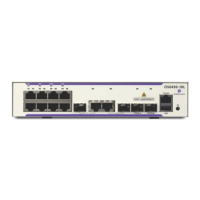page 21-10 OmniSwitch AOS Release 7 Network Configuration Guide March 2011
Congestion Management
Queuing mechanisms are used to manage congestion on egress ports. When congestion occurs, packets are
prioritized and placed into queues based on the CoS markings assigned to the packets during classifica-
tion. If there is no congestion on the egress port, packets are sent out as soon as they are received.
The OmniSwitch 10K is an input-queue switch. Queue management is done on the ingress based on a
virtual output queue (VOQ) architecture that is inherent to the switch.
• The ingress queue management function on each switch NI allocates a set of eight physical VOQs for
every port in the system, including ports that belong to the NI. These VOQs are “virtual” in that they
serve as egress queues for a port but are located and managed on the ingress.
• Extended memory on the ingress provides deep packet buffering to absorb short periods of congestion
without dropping traffic.
• An advanced feedback mechanism from egress to the ingress buffers traffic on ingress to prevent head-
of-line (HOL) blocking.
• A centralized scheduler schedules traffic to every port based on inputs from all the ingress VOQs
destined to the egress port.
• Traffic is scheduled through the switch fabric based on the egress port speed, thus providing efficient
use of the fabric bandwidth.
The following diagram shows the components within the system that provide the QoS features and input-
based queuing using VOQs:
Generic VOQ Data Flow Example
Ingress Packet
Processor
(PP)
Egress Packet
Processor
(PP)
Egress Traffic
Manager
(TM)
Ingress Traffic
Manager
(TM)
Centralized
Scheduler
1. Classifies, routes, and switches packets received
on the NI. Applies QoS policies. Determines
packet destination port for unicast traffic or multi-
cast group ID (MGID).
2. Selects VOQs associated with
packet destination. Queues data
based on pre-defined scheduling/
bandwidth parameters.
3. Schedules ingress TM data flow through switch fabric to egress TM, where data is
then stored in per-port/CoS FIFO queues. The Scheduler monitors the availability of
buffer space on the egress port to determine if ingress TM can send data. Applies
queue scheduling profiles to VOQs for admission control and bandwidth management.
Switch
Fabric
Ingress NI
Egress NI
Data Flow
4. FIFO queues send the data to
the egress PP.
Feedback Path to ingress TM per Port, CoS
5. Performs normal PP egress packet
modification, such as VLAN tag process-
ing, multicast routing updates, etc.

